Imagine a smartphone market where innovation is no longer just about bigger screens or faster processors, but about how deeply a device can integrate into daily life with intelligent features and seamless design. Google’s latest flagships, the Pixel 10 Pro and Pro XL, have entered this arena, promising to redefine user expectations with cutting-edge AI and refined aesthetics. This roundup gathers insights from a variety of tech analysts, reviewers, and industry voices to explore whether these devices truly stand out in a crowded field dominated by heavyweights like Apple and Samsung. The purpose is to provide a comprehensive view of early impressions, highlighting strengths, criticisms, and potential impacts of these new offerings.
Unveiling Google’s Flagship Duo: First Impressions
Initial reactions to the Pixel 10 Pro and Pro XL center on their role as successors to a well-regarded lineage, building on a foundation of software prowess. Many tech observers note that Google continues to position itself as a unique player by emphasizing practical innovations over raw power. A common sentiment is excitement about how these devices might challenge the status quo with features tailored for real-world utility. This section compiles varied perspectives on the unveiling, setting the stage for deeper dives into specific aspects.
The consensus among early hands-on reports is that Google’s focus remains on creating a cohesive experience rather than competing solely on specs. Some industry watchers appreciate this approach, suggesting it caters to users seeking more intuitive interactions. Others, however, express curiosity about whether such a strategy will resonate in a market often driven by benchmark numbers and flashy hardware upgrades.
A recurring theme from initial feedback is the anticipation surrounding Google’s ability to carve a niche. Analysts highlight that while the devices may not revolutionize the industry overnight, their subtle advancements could influence long-term trends. This blend of cautious optimism and critical inquiry shapes the broader discussion on what these flagships represent.
Design and Build: Aesthetic Continuity or Missed Opportunity?
Refined Looks with Functional Additions
Feedback on the design of the Pixel 10 Pro and Pro XL reveals a general appreciation for Google’s decision to maintain continuity from previous models while introducing practical enhancements. Many reviewers commend the sleek, durable form factor, often citing elegant color options like Moonstone and Jade as visually appealing. The addition of Pixelsnap magnets for accessory integration garners particular praise for bringing Android users closer to an ecosystem similar to Apple’s MagSafe.
However, not all opinions align on the impact of these design choices. Some voices in the tech community argue that while the build quality feels premium, the overall aesthetic lacks the boldness needed to truly differentiate from competitors. This critique often points to the subtle nature of updates as potentially underwhelming for users craving a dramatic visual shift.
A smaller subset of feedback focuses on minor design elements deemed unnecessary. For instance, the inclusion of a temperature sensor draws skepticism from several analysts who question its practical value. Despite such criticisms, the majority view holds that the design strikes a balance between familiarity and innovation, appealing to a wide audience.
Competitive Edge in Form Factor
When compared to rival flagships, opinions vary on how the Pixel 10 series stands out aesthetically. Certain reviewers argue that Google’s design outpaces the iterative updates seen in recent offerings from Apple and Samsung, particularly in terms of durability and finish. This perspective often emphasizes the phones’ ability to feel modern without alienating existing fans.
Contrasting views suggest that while the form factor is impressive, it doesn’t push boundaries far enough to redefine industry standards. Some industry commentators note that competitors’ designs, though stagnant, benefit from brand recognition that Google still struggles to match fully. This debate underscores a divide on whether aesthetics alone can drive market share.
Ultimately, the discussion around design reveals a nuanced picture. While many agree on the elegance and functionality of refinements like Pixelsnap, there remains a question of whether these changes are impactful enough to sway undecided buyers. This tension between admiration and critique fuels ongoing analysis of Google’s approach.
AI Innovations: Practical Tools or Unproven Promises?
Transformative Features in Focus
The AI capabilities of the Pixel 10 Pro and Pro XL emerge as a focal point across multiple reviews, with features like Live Translate and Magic Cue generating significant buzz. Tech analysts widely praise the on-device processing for privacy, noting that tools such as voice-mimicking translation could transform communication. The potential for contextual assistance in daily tasks is often highlighted as a game-changer.
Yet, skepticism persists due to limited testing opportunities in early hands-on sessions. Several industry voices caution that while the concepts sound revolutionary, their real-world effectiveness remains unverified. This uncertainty prompts calls for more extensive evaluations to determine if these features deliver on their ambitious promises.
A broader perspective from tech forums suggests that Google’s emphasis on practical AI sets it apart from competitors. Many note that while Apple’s AI rollout appears slower and Samsung’s efforts feel less cohesive, Google’s privacy-first approach resonates with growing consumer concerns. This positions the Pixel 10 series as a leader in user-centric innovation.
Comparing AI Strategies Across Brands
Differing opinions surface when comparing Google’s AI strategy to that of other tech giants. Some reviewers argue that Google’s tools are more immediately useful, focusing on everyday scenarios like translation and contextual help. This practicality is often contrasted with what is seen as Apple’s cautious integration of similar technologies.
On the flip side, a segment of analysts points out that Google’s reliance on AI might not appeal to all users if performance lags in other areas like raw processing power. Samsung’s mixed track record with AI also enters the conversation, with some suggesting that Google’s consistent focus gives it an edge. This comparison reveals a competitive landscape where software differentiation is key.
The dialogue around AI ultimately reflects a balance of enthusiasm and reservation. While many industry observers see Google paving the way for meaningful advancements, others stress the need for tangible results over time. This dynamic shapes expectations for how these features will evolve with user feedback.
Camera Capabilities: Software Over Hardware?
Computational Photography in the Spotlight
Early impressions of the camera system on the Pixel 10 Pro and Pro XL emphasize Google’s reliance on software enhancements over hardware upgrades. Reviewers frequently mention features like 100x Pro Res zoom and Camera Coach for real-time tips, applauding the potential for Tensor G5-driven improvements. The approach to computational photography garners attention for promising impressive results despite unchanged sensors.
However, opinions diverge on whether software alone can compete with rivals boasting larger sensors or more advanced hardware. Some tech enthusiasts express doubt, arguing that while Google’s past efforts have been strong, the lack of physical upgrades might limit performance in challenging conditions. This concern often calls for deeper testing to validate claims.
A more optimistic view from certain analysts highlights Google’s track record of leveraging software to punch above its weight. The consensus in this camp is that features like enhanced zoom could redefine expectations for smartphone photography. This optimism is tempered by a shared acknowledgment that real-world results will be the ultimate judge.
Global Standing and Industry Trends
When placed in a global context, the Pixel 10 series’ camera strategy sparks varied reactions. Some industry watchers position Google’s focus on software as aligned with broader trends toward computational imaging, suggesting it could keep pace with or even surpass competitors. This perspective often cites historical successes as evidence of capability.
Others argue that hardware remains a critical factor in markets where specs drive purchasing decisions. Comparisons to brands with cutting-edge sensor technology reveal a split in opinion on whether Google’s approach will maintain relevance. This debate underscores the challenge of balancing innovation with consumer expectations.
The camera discussion ultimately points to a pivotal moment for Google. While many see potential in software mastery, there is a clear demand for proof that these advancements translate into superior output. This unresolved question keeps the conversation open as more detailed reviews emerge.
Performance and Longevity: A Future-Proof Investment?
AI-Driven Power Over Raw Specs
Performance evaluations of the Pixel 10 Pro and Pro XL often focus on the Tensor G5 chipset’s prioritization of AI over traditional power metrics. Tech analysts generally agree that with 16GB of RAM, the devices are equipped for most tasks, though they may not lead in benchmark tests. This design choice is frequently seen as intentional, catering to users who value intelligent features.
A contrasting opinion from gaming-focused reviewers suggests that this focus might alienate performance-driven consumers. The sentiment here is that while adequate for casual use, the hardware may struggle with intensive applications compared to gaming-centric rivals. This critique highlights a potential gap in appeal for specific demographics.
Overall, many voices in the tech space view the performance strategy as a calculated trade-off. The emphasis on AI capabilities, coupled with long-term software support, is often praised as a forward-thinking move. This perspective frames the devices as built for sustained relevance rather than short-term dominance.
Seven Years of Updates as a Selling Point
The commitment to seven years of Android updates, starting from the current release through to future iterations, draws widespread approval across reviews. Industry commentators often cite this as a major differentiator, positioning the Pixel 10 series as a lasting investment. The potential for evolving AI features over time adds to this appeal.
Some analysts, however, question whether such long-term support will maintain user interest if hardware limitations become apparent sooner. This concern reflects a broader discussion on how software updates can offset physical obsolescence. The divide in opinion centers on user priorities and evolving tech needs.
A unifying thread in feedback is the recognition of Google’s intent to future-proof its flagships. This strategy is frequently contrasted with competitors offering shorter support cycles, suggesting a competitive edge in value. The discussion continues to evolve as real-world usage data becomes available.
Key Takeaways from Diverse Perspectives
Synthesizing insights from various tech voices reveals a multifaceted view of the Pixel 10 Pro and Pro XL. The design, with features like Pixelsnap, earns consistent praise for blending style and utility, though some feel it lacks daring. AI innovations stand out as a potential game-changer, with privacy-focused processing lauded, even as effectiveness remains under scrutiny due to limited testing.
Camera capabilities spark debate over the merits of software-driven improvements versus hardware upgrades, with opinions split on competitive standing. Performance discussions highlight a deliberate focus on AI over raw power, complemented by long-term update promises that many see as a significant advantage. These varied takes paint a picture of devices with unique strengths and unresolved questions.
A practical tip for potential buyers emerges from this roundup: prioritize software features and ecosystem integration over traditional metrics when considering these phones. For those intrigued by AI tools or accessory compatibility, the Pixel 10 series could offer unmatched utility. This collective feedback provides a starting point for informed decision-making.
Reflecting on the Broader Impact
Looking back, the discourse around the Pixel 10 Pro and Pro XL captured a pivotal moment in smartphone evolution, where software innovation and thoughtful design took center stage. The diverse opinions gathered in this roundup underscored Google’s distinct approach, balancing practical AI with refined aesthetics. This conversation illuminated how privacy-conscious features and long-term support shaped perceptions of value.
For those eager to dive deeper, exploring detailed reviews and user experiences as they become available offers a next step. Potential buyers might also consider testing these devices in-store to assess AI tools and design firsthand. As the industry continues to evolve, staying attuned to how Google refines its strategy based on feedback could provide further clarity on the lasting impact of this series.









